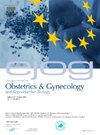2015-2021年爱尔兰四大妇产医院剖宫产率的变化趋势:哪些群体导致剖宫产率上升?
IF 1.9
4区 医学
Q2 OBSTETRICS & GYNECOLOGY
European journal of obstetrics, gynecology, and reproductive biology
Pub Date : 2025-10-02
DOI:10.1016/j.ejogrb.2025.114749
引用次数: 0
摘要
目的利用罗布森十组分类系统(TGCS)分析2015年至2021年间爱尔兰四大妇产医院剖腹产率的变化趋势。方法本回顾性队列研究回顾了2015年至2021年科克大学妇产医院、国家妇产医院、圆形医院和库姆医院的221,098例分娩。每个医院收集并提交给国家围产期审计中心(NPEC)的数据被合并成一个单一的数据集。使用线性回归进行统计分析,以确定根据TGCS的CS率和组贡献的趋势。采用Pearson系数评价统计学显著性。结果总CS率由2015年的30.13%显著上升至2021年的35.89% (p = 0.001)。这一增长的主要驱动因素是第二组和第五组,占增长的90%以上。第5组剖宫产率提高了6.52% (p = 0.001)。此外,第10组(早产)的剖腹产率显著增加了8% (p = 0.046)。其他TGCS组的剖宫产率变化无统计学意义。结论爱尔兰最大的妇产医院剖宫产率上升的主要原因是总体上第2组和第5组剖宫产率上升以及第5组剖宫产率上升。旨在降低总剖腹产率的有针对性的干预措施应侧重于这些特定群体,可能通过优化引产实践,促进产前剖腹产的共同决策。本文章由计算机程序翻译,如有差异,请以英文原文为准。
Changing trends in caesarean section rate in Ireland’s four largest maternity hospitals 2015–2021: which groups account for the rising caesarean section rate?
Objectives
To analyse the changing trends in Caesarean Section (CS) rates in Ireland’s four largest maternity hospitals between 2015 and 2021, utilizing the Robson Ten Group Classification System (TGCS).
Methods
This retrospective cohort study reviewed 221,098 deliveries from Cork University Maternity Hospital, The National Maternity Hospital, Rotunda Hospital, and The Coombe Hospital, spanning from 2015 to 2021. Data, collected by each individual hospital and submitted to the National Perinatal Audit Centre (NPEC), was combined into a single dataset. Statistical analysis was performed using linear regression to identify trends in CS rates and group contributions according to the TGCS. Pearson’s coefficient was employed to assess statistical significance.
Results
The overall CS rate significantly increased from 30.13 % in 2015 to 35.89 % in 2021 (p = 0.001). The primary drivers of this increase, accounting for over 90 % of the rise, were Group 2 and Group 5. Group 5 demonstrated a statistically significant increase in its Caesarean Section rate by 6.52 % (p = 0.001). Additionally, Group 10 (preterm birth) showed a significant increase in its Caesarean Section rate by 8 % (p = 0.046). Changes in Caesarean Section rates within other TGCS groups were not statistically significant.
Conclusion
The rising Caesarean Section rate in Ireland’s largest maternity hospitals is predominantly influenced by an increasing proportion of Group 2 and Group 5 overall and a higher Caesarean Section rate in Group 5. Targeted interventions aimed at reducing the overall CS rate should focus on these specific groups, potentially through optimizing induction practices, promoting shared decision-making regarding pre-labour Caesarean Section.
求助全文
通过发布文献求助,成功后即可免费获取论文全文。
去求助
来源期刊
CiteScore
4.60
自引率
3.80%
发文量
898
审稿时长
8.3 weeks
期刊介绍:
The European Journal of Obstetrics & Gynecology and Reproductive Biology is the leading general clinical journal covering the continent. It publishes peer reviewed original research articles, as well as a wide range of news, book reviews, biographical, historical and educational articles and a lively correspondence section. Fields covered include obstetrics, prenatal diagnosis, maternal-fetal medicine, perinatology, general gynecology, gynecologic oncology, uro-gynecology, reproductive medicine, infertility, reproductive endocrinology, sexual medicine and reproductive ethics. The European Journal of Obstetrics & Gynecology and Reproductive Biology provides a forum for scientific and clinical professional communication in obstetrics and gynecology throughout Europe and the world.

 求助内容:
求助内容: 应助结果提醒方式:
应助结果提醒方式:


